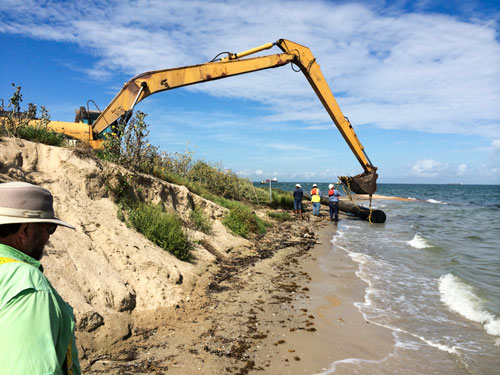
Calvin Jackson of Port O’Connor watching Orion Marine Group’s crew pull the dredge discharge pipe in place before pumping on the Northeast end of Chester Island.
September was a big month at the Chester Island Bird Sanctuary (also known as Sundown Island). As the record-breaking 2014 nesting season came to an end on this important colonial waterbird rookery site, Orion Marine Group began a maintenance-dredging project for the U.S. Army Corps of Engineers in the nearby Matagorda Shipping Channel (www.dredgingtoday.com/2014/09/04/orion-marine-nabs-matagorda-dredging-contract-usa/). This is critical work to maintaining safe navigation for the large ships that travel daily between the Gulf of Mexico and the Lavaca Bay plants. It is also critical work for Chester Island as sediment removed from the ship channel is used to create new beach along our shoreline.
Chester Island has all of the characteristics required for a successful colonial waterbird rookery: lack of predators, good foraging habitat nearby, proper nesting substrate/vegetation and lack of human disturbance. In fact, birds like it so much that they travel from as far away as Florida and Mexico to nest here. I would like to thank the local fishermen and boaters who are generally respectful of the signs instructing no walking or boat landing on the island. Your continued cooperation helps more young birds survive, when their parents aren’t scared off their nests by frequent human disturbance.
But this rookery island is under constant attack from strong currents, waves, winds, ship wakes, and storms —and the resulting shoreline erosion destroys bird habitat, and has shrunk the size of the island by over 20% since 2001. The rate of loss along portions of the shoreline has accelerated in recent years—believed to be as a result of the silting of Pass Cavallo causing increased tidal currents through the Matagorda Ship Channel jetties and around Chester Island. If nothing is done to combat this shoreline erosion, the island will eventually disappear. Beach nourishment from nearby dredging is a very important way of offsetting the erosion. It also provides new habitat important for ground nesting species like Royal Terns, Sandwich Terns and Black Skimmers.
The Corps of Engineers and Orion worked with Audubon Texas staff over the past few months to plan and coordinate the best use of 126,000 cubic yards of dredge spoil expected from Section 1 of the Matagorda Ship Channel—the 8,000 foot-long section of the channel just inside the jetties and immediately offsetting Chester Island. The Section 1 phase of the dredging project will provide a needed boost in the fight against erosion. Dredge spoil from areas outside of Section 1 are pumped elsewhere in the bay system, and do not currently benefit Chester Island.
But Audubon Texas and U. S. Fish & Wildlife Service are looking for longer-term solutions and have joined together to study alternatives for Chester Island shoreline protection and habitat restoration. One option is a Cost Sharing Agreement with the Corps of Engineers whereby Audubon and its partners could pay the additional costs to pump dredge spoil to Chester Island from longer distances. Other but more expensive options include adding a system of hardened structures around parts of the island to provide more permanent protection and significantly reduce the rate of erosional losses. If successful, these efforts should help preserve this vital resource for the Texas Gulf Coast bird population.
For more information, see Audubon Texas’ website: http://tx.audubon.org/coastal-stewardship-program and the Friends of Chester Island’s website: http://www.chesterisland.org.
